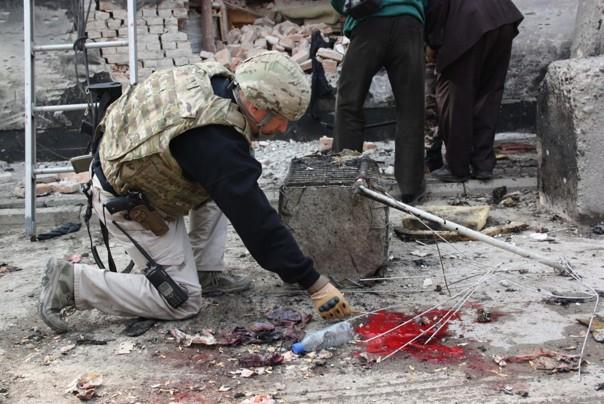November 22, 2012
KABUL — A pair of suicide bombers in Afghan military uniforms penetrated the most heavily guarded district in Kabul early Wednesday, killing two Afghan security guards and wounding five civilians in blasts at a checkpoint near the main U.S. military headquarters and half a dozen other international facilities.

November 22, 2012
KABUL — A pair of suicide bombers in Afghan military uniforms penetrated the most heavily guarded district in Kabul early Wednesday, killing two Afghan security guards and wounding five civilians in blasts at a checkpoint near the main U.S. military headquarters and half a dozen other international facilities.

Afghan and NATO's soldiers inspect the scene of a suicide bomb blast targeting a US military base in Kabul, on Nov. 21, 2012.
Police officials said the bombers’ target was probably Camp Eggers, the large U.S. military compound that occupies several square blocks of the capital’s exclusive Wazir Akbar Khan neighborhood. But a spokesman for the radical Islamist Taliban movement said the attack was aimed at a CIA compound and that “a large number” of insurgents had participated.
The attack during morning rush hour quickly emptied the city’s normally congested streets. It immediately intensified public worries about violence during the Shiite Muslim holy period of Muharram, which is to climax Sunday with street processions and ritual self-flagellation. Last year during Muharram, a terrorist bombing near a Shiite shrine in Kabul took 54 lives.
But Afghan officials noted that the bombers targeted a district dominated by foreign and official buildings, embassies and bases, which is nowhere near any Shiite neighborhoods or activities. The whole city is full of black archways and colorful banners marking Muharram, but most Shiites live and worship several miles from Wazir Akbar Khan in West Kabul.
The blocks immediately surrounding the blast site include the embassies of Pakistan and Canada, a security company and the home of the chief justice of the Afghan Supreme Court. The U.S. Embassy is several blocks away, as are restaurants frequented by Westerners and the offices of the World Bank.
According to police, the bombers walked through multiple checkpoints into the heart of the high-security zone about 8 a.m. and were spotted by guards at another post. They said the guards opened fire and the bombers’ suicide vests exploded.
Several hours later, a large jagged hole was visible at the scene of the blast. Charred metal and debris littered the street, and fire trucks were hosing it down. A guard post where the two Afghan security guards were killed was also charred black. A U.S. military tow truck was hauling away an armored sport-utility vehicle with shattered windows.
Police investigators at the scene said one of the bombers was a man in his 30s or 40s wearing an Afghan National Army uniform. He was apparently able to walk nearly four blocks, through multiple checkpoints, to the spot where he confronted the guards and detonated his explosives.
“It is still confusing what was the target. There are so many possible ones right here,” one investigator said. He said the damaged SUV belonged to a senior Afghan army general, who might have been the object of the attack. The general was said to be unharmed.
Another senior police official said the bomber might have been attempting to enter a vacant building under construction near the sensitive compounds. Several previous terrorist attacks in Kabul have been launched from such unoccupied buildings, and officials have been working to make them more secure.
Courtesy: WP
















































































































